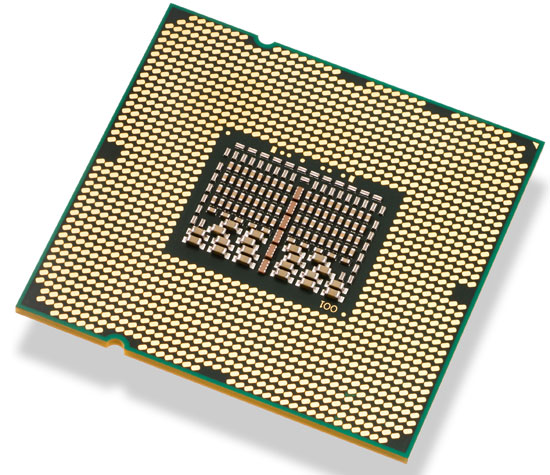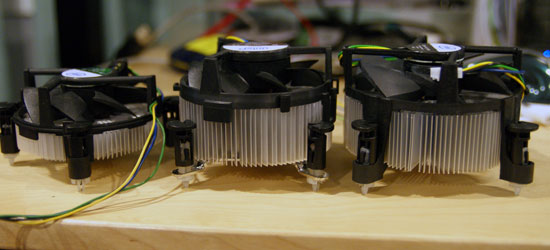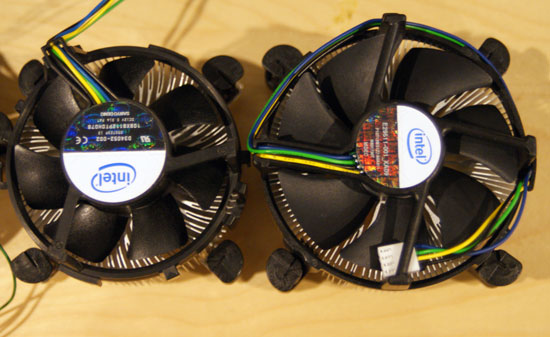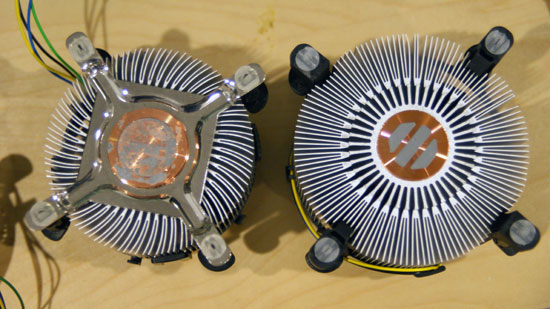The Dark Knight: Intel's Core i7
by Anand Lal Shimpi & Gary Key on November 3, 2008 12:00 AM EST- Posted in
- CPUs
The Chips
With a new microarchitecture comes a new naming system and while it makes sense for Intel to ditch the Duo/Quad suffixes that's about the only sensible thing that we get with Nehalem's marketing. The new name has already been announced, Nehalem is officially known as the Intel Core i7 processor. Model numbers are back of course and the three chips that Intel is announcing today are the 965, 940 and 920. The specs break down like this:
| Processor | Clock Speed | QPI Speed (GT/sec) | L3 Cache | Memory Speed Support | TDP | Unlocked? | Price |
| Intel Core i7-965 Extreme Edition | 3.20GHz | 6.4 | 8MB | DDR3-1066 | 130W | Yes | $999 |
| Intel Core i7-940 | 2.93GHz | 4.8 | 8MB | DDR3-1066 | 130W | No | $562 |
| Intel Core i7-920 | 2.66GHz | 4.8 | 8MB | DDR3-1066 | 130W | No | $284 |
Obviously there's no changing Intel's naming system now, but I'd just like to voice my disapproval with regards to the naming system. It just doesn't sound very good.
These chips aren't launching today, Intel is simply letting us talk about them today. You can expect an official launch with availability by the end of the month.
The Socket
By moving the memory controller on-die Intel dramatically increased the pincount of its processor. While AMD's Phenom featured a 940-pin pinout, Intel's previous Core 2 processors only had 775 contact pads on their underside. With three 64-bit DDR3 channels however, Intel's Core i7's ballooned to 1366 pads making the chip and socket both physically larger:

The downside to integrating a memory controller is that if there are any changes in memory technology or in the number of memory channels, you need a new socket. Sometime in 2009 Intel will introduce a cheaper Nehalem derivative with only a 2-channel memory controller, most likely to compete in the < $200 CPU price points. These CPUs will use a LGA-1156 socket, but future 8-core versions of Nehalem will use LGA-1366 like the CPUs we're reviewing here today.
The larger socket also requires a bigger heatsink, here's a look at the new Intel reference cooler:

From left to right: 45nm Core 2 Duo cooler, 45nm Core 2 Quad cooler, 45nm Core i7 Cooler












73 Comments
View All Comments
Clauzii - Thursday, November 6, 2008 - link
I still use PS/2. None of the USB keyboards I've borrowed or tried out would work in 'boot'. Also I think a PS/2 keyboard/mouse don't lag so much, maybe because it has it's own non-shared interrupt line.But I can see a problem with PS/2 in the future, with keyboards like the Art Lebedev ones. When that technology gets more pocket friendly I'd gladly like to see upgraded but still dedicated keyboard/mouse connectors.
The0ne - Monday, November 3, 2008 - link
Yes. I have the PS2 keyboard on-hand in case my USB keyboard can't get in :)Strid - Monday, November 3, 2008 - link
Ahh, makes sense. Thanks for clarifying!Genx87 - Monday, November 3, 2008 - link
After living through the hell that were ATI drivers back in 2003-2004 on a 9600 Pro AIW. I didnt learn and I plopped money down on a 4850 and have had terrible driver quality since. More BSOD from the ati driver than I have had in windows in the past 5 years combined from anything. Back to Nvidia for me when I get a chance.That said this review is pretty much what I expected after reading the preview article in August. They are really trying to recapture market in the 4 socket space. A place where AMD has been able to do well. This chip is designed for server work. Ill pick one up after my E8400 runs out of steam.
Griswold - Tuesday, November 4, 2008 - link
You're just not clever enough to setup your system properly. I have two indentical systems sitting here side by side with the only difference being the video card (HD3870 in one and a 8800GT in the other) and the box with the nvidia cards gives me order of magnitude more headaches due to crashing driver. While that also happens on the 3870 machine now and then, its nowehere nearly as often. But the best part: none of the produces a BSOD. That is why I know you're most likely the culprit (the alternative is faulty hardware or a pathetic overclock).Lord 666 - Monday, November 3, 2008 - link
The stock speed of a Q9550 is 2.83ghz, not 2.66qhz.Why the handicap?
Anand Lal Shimpi - Monday, November 3, 2008 - link
My mistake, it was a Q9450 that was used. The Q9550 label was from an earlier version of the spreadsheet that got canned due to time constraints. I wanted a clock-for-clock comparison with the i7-920 which runs at 2.66GHz.Take care,
Anand
faxon - Monday, November 3, 2008 - link
toms hardware published an article detailing that there would be a cap on how high you are allowed to clock your part before it would downclock it back to stock. since this is an integrated par of the core, you can only turn it off/up/down if they unlock it. the limit was supposedly a 130watt thermal dissipation mark. what effect did this have in your tests on overclocking the 920?Gary Key - Monday, November 3, 2008 - link
We have not had any problems clocking our 920 to the 3.6GHz~3.8GHz level with proper cooling. The 920, 940, and 965 will all clock down as core temps increase above the 80C level. We noticed half step decreases above 80C or so and watched our core multipliers throttle down to as low as 5.5 when core temps exceeded 90C and then increase back to normal as temperatures were lowered.This occurred with stock voltages or with the VCore set to 1.5V, it was dependent on thermals, not voltages or clock speeds in our tests. That said, I am still running a battery of tests on the 920 right now, but I have not seen an artificial cap yet. That does not mean it might not exist, just that we have not triggered it yet.
I will try the 920 on the Intel board that Toms used this morning to see if it operates any differently than the ASUS and MSI boards.
Th3Eagle - Monday, November 3, 2008 - link
I wonder how close you came to those temperatures while overclocking these processors.The 920 to 3.6/3.8 is a nice overclock but I wonder what you mean by proper cooling and how close you came to crossing the 80C "boundary"?